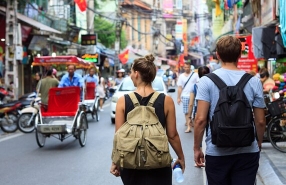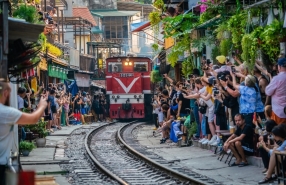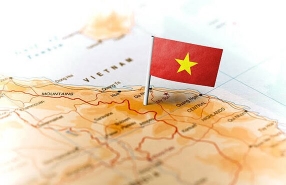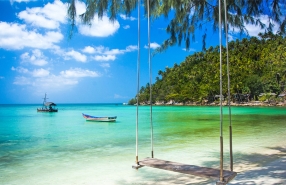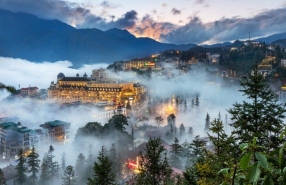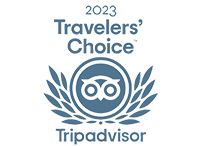When To Visit Rice Fields In Vietnam? Things To Know About Rice Fields

Vietnam is an agricultural country, so rice fields are not only closely tied to Vietnamese culture but are also a dominant landscape throughout the territory, appearing in every region. Surely, you have come across impressive images of Vietnam golden rice fields if you’ve ever searched for information about this country, sparking in you the desire to witness this poetic scenery firsthand. Let’s explore essential information about the most famous places to see rice fields in Vietnam, as well as the best times to visit Vietnam rice fields.
Discovery of Vietnam rice fields
I. When to see the Vietnam rice fields?
1. The rice cycle
Before visiting the Vietnam rice fields, you need to gather information about the rice growing seasons to determine the best time for your visit. The rice cycle includes several phases: the planting season, during which the fields are mainly covered with water, and farmers are transplanting seedlings; the green rice season, when the seedlings sprout and grow; the ripe rice season, when the fields turn golden; and finally, the harvest season. Due to Vietnam's elongated geography, with regions having different terrains and climates, each area experiences its own distinct growing seasons.
- Red River Delta: This region has two rice crops per year. One season begins in late October and is harvested in May of the following year, while the other starts in May and ends in November.
- Northwestern Mountainous Area: Due to the mountainous terrain, the terraced fields have only one crop annually. Farmers typically start planting rice in May, with the harvest occurring in September and October.
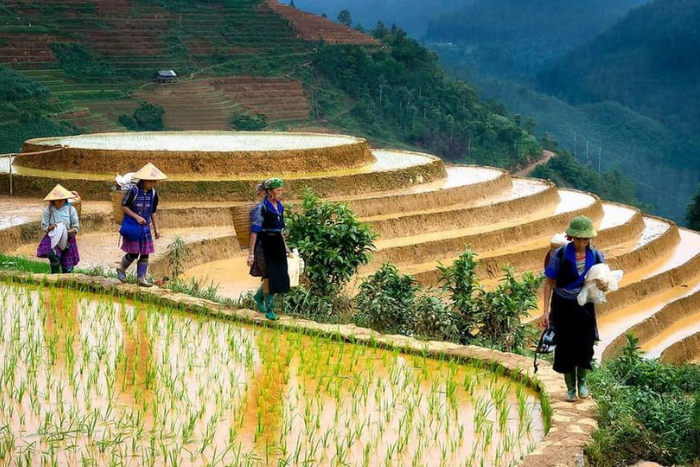
- Central Coastal Region: There are three main rice crops: one starts sowing in late April and is harvested at the end of September; another winter-spring crop begins in late October and is harvested in April of the following year. The last crop starts sowing in late May and is harvested at the end of November.
- Mekong Delta: Thanks to favorable conditions, the Mekong Delta is Vietnam’s largest rice granary. The rainy-season rice crop is sown in May or June and harvested in late November. Another crop starts in late November and is harvested in early April of the following year.
2. The best time to see rice fields in Vietnam
When to see rice fields in Vietnam? At any given time, Vietnam rice fields exhibit a unique beauty and offer distinct experiences. Therefore, for regular rice fields, you can visit them year-round and in various locations during your Vietnam trip, except for a few months of rain in the Central region. However, if you wish to admire terraced rice fields, it’s a bit more complicated, as these fields only have rice for one-third of the year due to the complex terrain.
Visit Vietnam rice paddies during the rice planting season, the fields are flooded with water, forming vast mirrors where the sky and clouds are reflected. This landscape is most evident in the terraced rice fields of Northwest Vietnam.
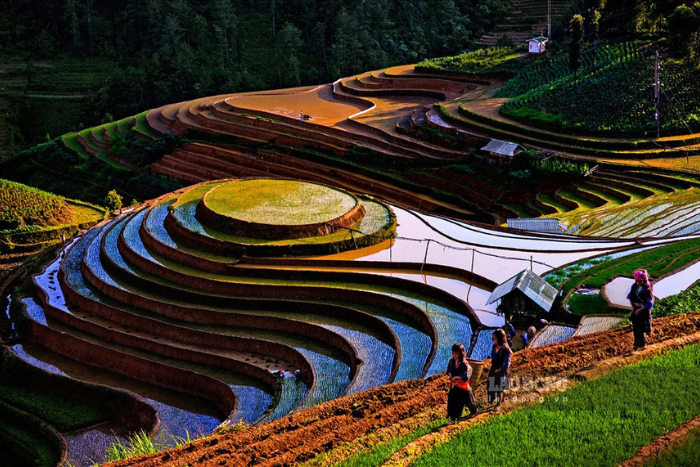
During the green and ripening phases of the rice, Vietnam rice fields take on expansive shades of green or gold, creating a scene that is both majestic and poetic.Golden rice fields are a poetic landscape in the mountainous regions of Northern Vietnam, which immediately captivates tourists.
>>> Best time to visit Vietnam
II. Where to see rice fields in Vietnam?
1. Northern Vietnam
a. Ninh Binh
Where to see rice fields in Vietnam? For typical rice fields planted in plains or valleys, you can visit Ninh Binh or Lang Son. Located about 100 km from Hanoi, Ninh Binh is not only famous for its unique tourist attractions but also renowned for its stunning golden rice fields during harvest season. Near the Tam Coc caves, across the Ngo Dong River that winds through the mountains, lies a vast expanse of rice fields.
When to visit Ninh Binh? The fields are at their most beautiful during the ripening season, forming a golden carpet nestled among the mountains. You can choose to enjoy a panoramic view of the Tam Coc rice fields from the mountaintops or take a boat ride along the Ngo Dong River to immerse yourself in the rural landscape and touch the rice plants.
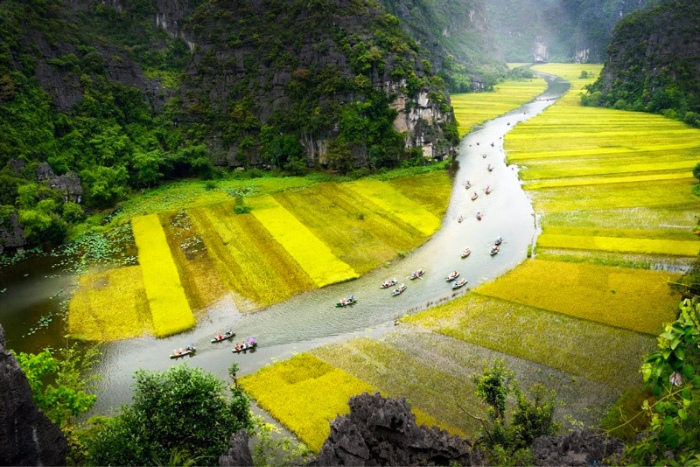
So, when is the best time to see the golden Ninh binh rice fields - one of the most beautiful rice fields in Vietnam? To “hunt” for this breathtaking scenery, you should visit between mid-May and late June. During this time, the Tam Coc rice fields in Ninh Binh are in the harvest season, creating a golden tapestry stretching far and wide. Visit Ninh Binh at this time to explore its remarkable caves while enjoying the fragrance of ripened rice.
b. Sa Pa
Where to see rice fields in Northern Vietnam? Sapa has long been a famous tourist destination in Vietnam for international visitors and is also renowned for its terraced fields. Sapa once made it to the top 7 most beautiful terraced fields in Asia and the top 30 most beautiful terraced fields in the world. Therefore, your trip to Vietnam would be incomplete without admiring the beauty of Sapa rice fields.
From above, the terraced fields stretch along the mountainsides, winding and intertwining to create stunning shapes. Amid the fields, you can spot the houses of ethnic minorities living in Sapa, water buffaloes, and farmers. The rice growing season in Sapa and other northern mountainous provinces is quite short, lasting from April and May to September and October each year. However, the terraced fields are beautiful all year round.
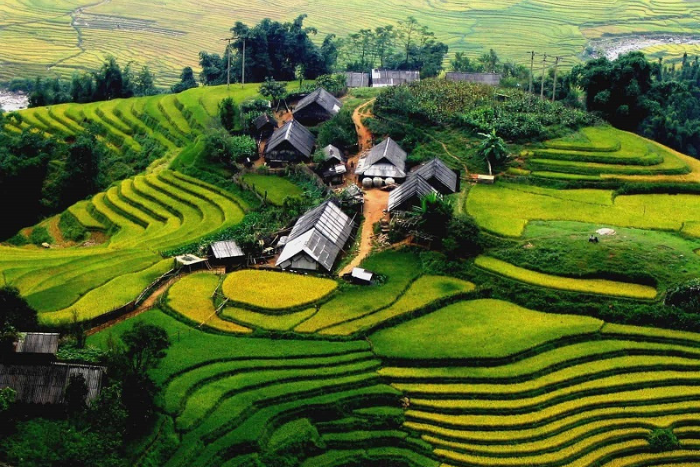
When to see Sapa rice fields? During the rice planting season, you can see the fields submerged in water, turning into giant mirrors reflecting the sky, as well as watch locals sowing rice. During the green rice season, the hills and mountains are blanketed in a fresh green color, creating a poetic landscape. In the ripe rice season, which falls in September and October, the golden hue of ripe rice covers the hills, forming a magnificent view. This is also the time that attracts the most tourists to Sapa.
When visiting Sapa, you can explore famous tourist spots and easily spot Vietnam rice fields along the way, as Sapa’s terrain is primarily mountainous. You can also discover the unique cultural features of Vietnam’s ethnic minorities in Sapa.
You may be interested in:
>>> 3-day itinerary in Sapa
>>> 5 days in Sapa
c. Yen Bai - Mu Cang Chai rice terraces
Recognized as a national heritage site, the Mu Cang Chai terraced fields in Yen Bai are among the top 10 most beautiful rice fields in Vietnam, attracting a large number of tourists every year. These fields are considered a masterpiece created by the Hmong ethnic group, as viewed from above, the terraced fields resemble layers of clothing draped over the hills.
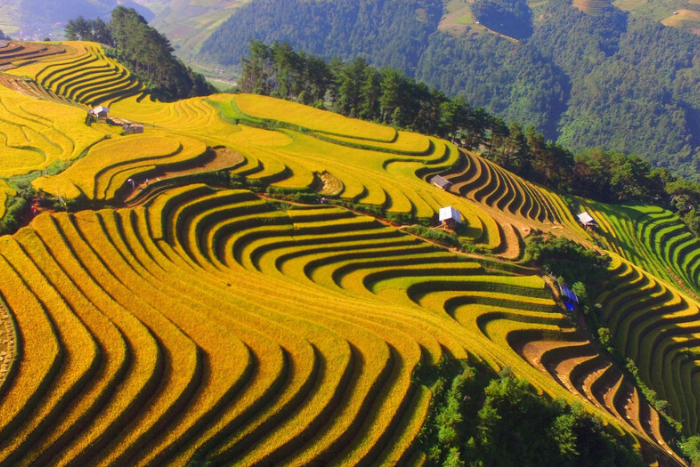
Where to see golden rice fields in Vietnam? Autumn marks the harvest season, when the golden rice fields create a majestic beauty that captivates visitors. This is an ideal destination for travelers who enjoy exploring Vietnam's mountainous regions and prefer cool climates.
d. Ha Giang - Hoang Su Phi
Ha Giang has become one of the most popular tourist destinations in recent years, especially among adventurous young travelers by the magnificent beauty of Ha Giang rice fields. Located in the mountainous region of Northwest Vietnam, Ha Giang boasts rustic and untouched beauty, far removed from the hustle and bustle of Hanoi.
With its complex terrain, including high mountains and steep slopes rising from the south to the north, Ha Giang appeals not only to daring young adventurers exploring by motorbike but also to those drawn by its magnificent mountainous landscapes. The Hoang Su Phi area in Ha Giang is particularly renowned for its vast and highest terraced fields in Vietnam. The golden rice field season in Ha Giang is late September, so don't forget to put this place on your list if you travel to Vietnam in autumn.
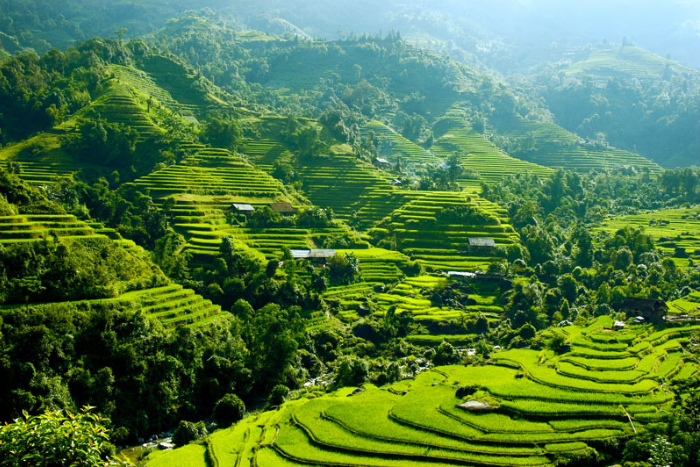
2. Other regions
An Giang - Ta Pa Rice Field
Where to see rice fields in Southeast Vietnam? With its favorable natural conditions and climate, the Mekong Delta is Vietnam's largest rice bowl, therefore the Mekong Delta has long been renowned for its expansive rice fields. Among them, the Ta Pa Rice Field stands out, located at the foot of the Ta Pa and Co To Mountains, about 1 km from Tri Ton town in An Giang province. What makes this field unique is the Khmer people's distinctive farming practice. They cultivate each plot together, creating a captivating mosaic of colors: lush green rice fields, golden squares of ripened rice, and deep brown plots where the soil has been freshly harvested. Discovering Vietnam rice fields is one of the things to do during your trip to South Vietnam.
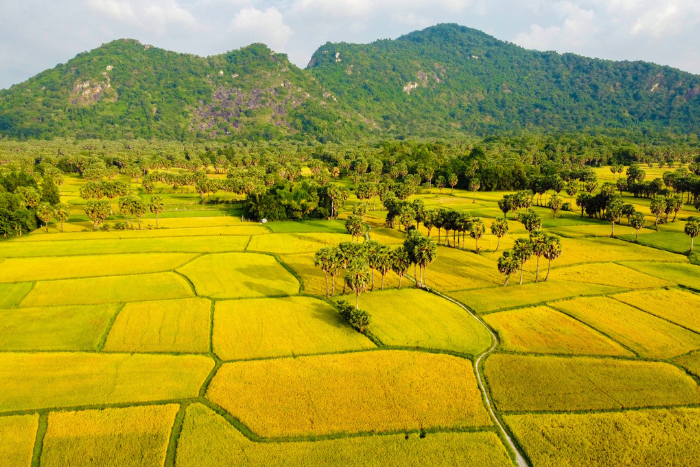
III. Activities during a visit to the rice fields
What to do when visiting Vietnam rice fields? You can refer to the following information to make your discovery of rice fields unforgettable.
1. Taking Photos
One of the must-do activities when visiting rice fields is capturing their most stunning moments. The sprawling, golden rice fields or the green stretches of rice along the mountainsides create picturesque landscapes, making it easy to take beautiful photographs. Especially during sunset, Vietnam terraced fields offer an even more breathtaking view.
2. Interacting with Ethnic Minorities
On the winding mountain roads of Northern Vietnam, where tourists often stop to admire the terraced fields from above, it’s common to encounter ethnic minority children along the way. Young girls in unique traditional clothing and large flower baskets on their backs in Ha Giang often catch the attention of international visitors. Many travelers stop to interact, take photos, and play with these ethnic minority children.
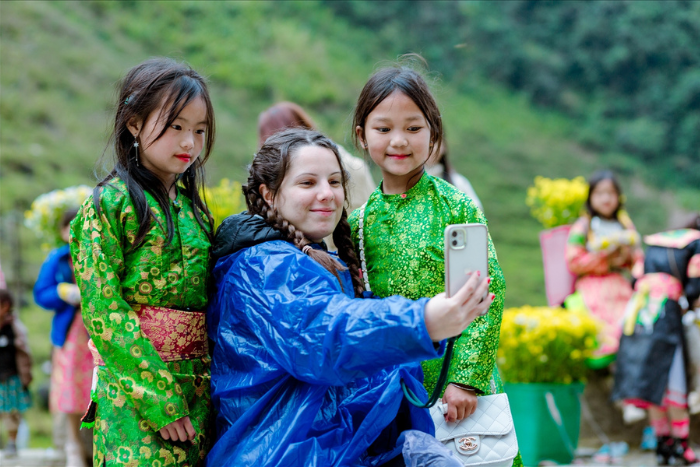
3. Experiencing Farming
During your visit to Vietnam rice fields, don’t miss the chance to join the locals in the rice fields and learn about Vietnam's rice farming culture. Many tourists find it exciting to participate in activities such as wading through the mud, planting rice, harvesting crops with buffaloes, learning how to sow seeds, and experiencing the daily life of farmers.
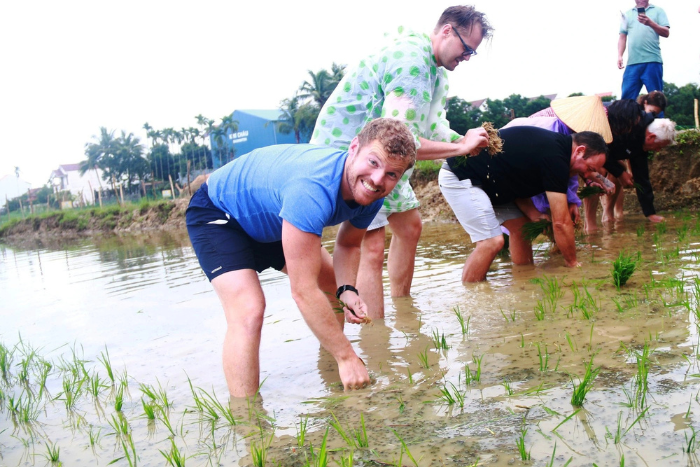
In general, admiring Vietnam rice fields is a must-do experience during your Vietnam tour. Rice fields can be found across the country, each region offering its own unique beauty and characteristics. When to visit rice fields in Vietnam? The best time to visit is during the harvest season when the rice is ripe. The most stunning locations to see Vietnam rice fields are in the mountainous regions of Northwest Vietnam, where terraced fields cascade beautifully along the mountainsides. You can not only capture breathtaking views but also take part in rice farming activities with the locals – an unforgettable experience.
You may also like:
>>> Sapa 5-day itinerary
>>> South Vietnam tours
>>> 5 days in Ha Giang
>>> All things to do in Ninh Binh
>>> Vietnam Travel guide
When to see rice fields in Vietnam? Except for the period from June to August, when most of the delta is flooded, you are almost guaranteed to see endless green fields at any time of the year in the delta. As for the terraced fields in the mountains of Northern Vietnam, June and July are the months when you can easily see green rice fields stretching across the mountains.
You can refer to the Sapa tour recommended by Autour Asia to visit Sapa rice fields. The rice terraces of Sapa are abundant, but the most stunning ones are located in the villages of Y Linh Ho, Ta Van, and Lao Chai, nestled in the Muong Hoa Valley. These terraces span nearly 1,000 hectares, making them the largest and most picturesque in the region, offering breathtaking views and a chance to witness traditional farming practices.
You can spend 5 days in Ninh Binh to explore Trang An Landscape Complex, a UNESCO World Heritage Site known for its stunning limestone karsts and waterways. Visit Bai Dinh Pagoda, the largest Buddhist temple complex in Vietnam, and admire its magnificent architecture. Don't miss Hoa Lu Ancient Capital, the historic center of Vietnam's first imperial dynasty.
Related travel guide
Other similar articles
CUSTOMIZABLE BY LOCAL EXPERTS
Personalized trip at the original price!
REFUND GUARANTEE
We believe in our work and promise to give you money back.
GOOD PRICE / QUALITY
95% satisfied more than expected!
24/7 LOCAL SUPPORT
We are always available online to provide assistance at any time.
Most read articles
Autour Asia is highly recommended on
Embracing the mission of "Satisfied more than expected" and providing authentic experiences, we have received numerous recommendations on reputable travel forums:













